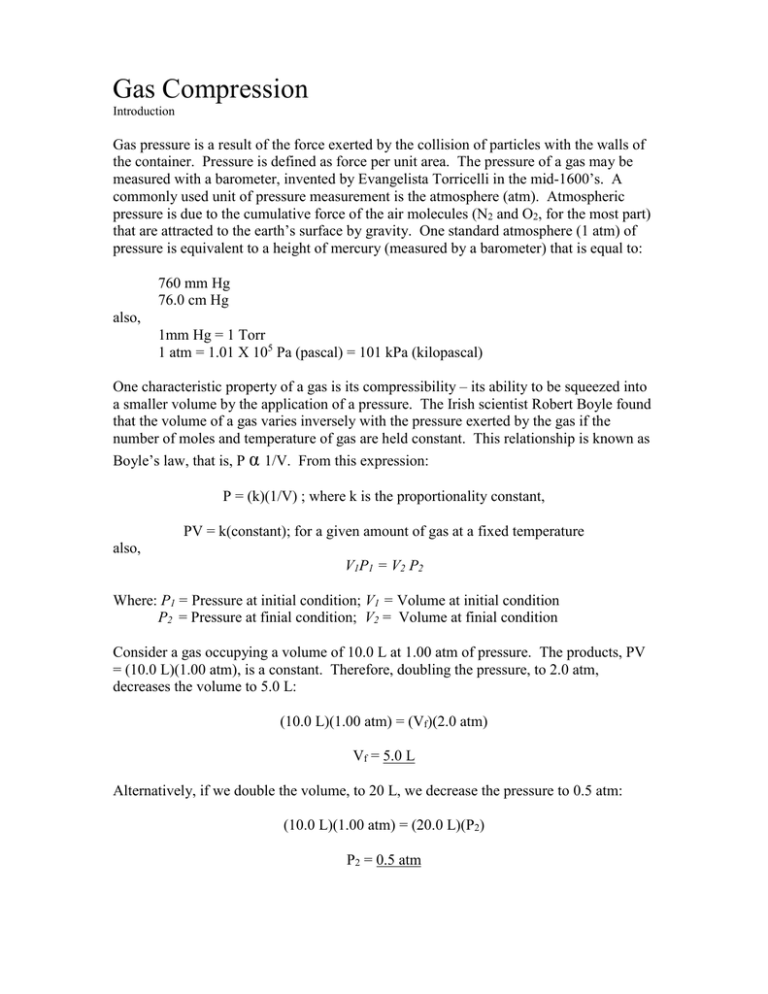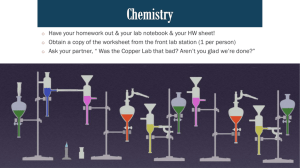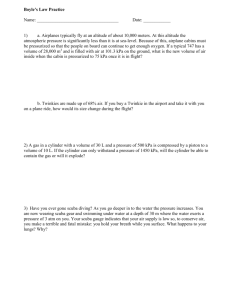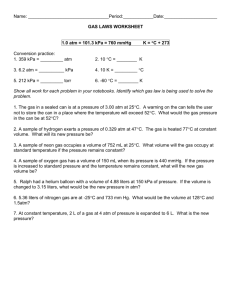Gas_Compression_Lab.doc
advertisement

Gas Compression Introduction Gas pressure is a result of the force exerted by the collision of particles with the walls of the container. Pressure is defined as force per unit area. The pressure of a gas may be measured with a barometer, invented by Evangelista Torricelli in the mid-1600’s. A commonly used unit of pressure measurement is the atmosphere (atm). Atmospheric pressure is due to the cumulative force of the air molecules (N2 and O2, for the most part) that are attracted to the earth’s surface by gravity. One standard atmosphere (1 atm) of pressure is equivalent to a height of mercury (measured by a barometer) that is equal to: 760 mm Hg 76.0 cm Hg also, 1mm Hg = 1 Torr 1 atm = 1.01 X 105 Pa (pascal) = 101 kPa (kilopascal) One characteristic property of a gas is its compressibility – its ability to be squeezed into a smaller volume by the application of a pressure. The Irish scientist Robert Boyle found that the volume of a gas varies inversely with the pressure exerted by the gas if the number of moles and temperature of gas are held constant. This relationship is known as Boyle’s law, that is, P α 1/V. From this expression: P = (k)(1/V) ; where k is the proportionality constant, PV = k(constant); for a given amount of gas at a fixed temperature also, V1P1 = V2 P2 Where: P1 = Pressure at initial condition; V1 = Volume at initial condition P2 = Pressure at finial condition; V2 = Volume at finial condition Consider a gas occupying a volume of 10.0 L at 1.00 atm of pressure. The products, PV = (10.0 L)(1.00 atm), is a constant. Therefore, doubling the pressure, to 2.0 atm, decreases the volume to 5.0 L: (10.0 L)(1.00 atm) = (Vf)(2.0 atm) Vf = 5.0 L Alternatively, if we double the volume, to 20 L, we decrease the pressure to 0.5 atm: (10.0 L)(1.00 atm) = (20.0 L)(P2) P2 = 0.5 atm In this experiment, the plunger of a 60-mL syringe will be depressed four times and the resulting pressures measured. Assume that on the day of the experiment, the atmospheric pressure read as 98 kPa. Note: In your observations, each pressure measurement is the sum of the value shown on the gauge plus the atmospheric pressure. Gas Compression Procedure **NOTE: Use instructions provide by the instructor – DO NOT USE INSTRUCTIONS IN CHEMLAB! To remove the instructions on the screen, and free-up more working area, perform the following operation: click on the OPTIONS tab; then click on LAB ONLY. The instructions “disappear” and all of the area is now lab space.** Step 1: Obtain a 60ml Syringe with Gauge from the Gas Syringe item under the Equipment menu. Use the Initial Gas Syringe - Volume dialog box to set the initial Syringe Volume to 50 ml. Record the resulting pressure in the Observations (Trial 1). Step 2: Select the syringe (right click on syringe) and then select the Set Gas Syringe Volume dialog box from under the Procedures menu or from the right-mouse button context menu. Reduce the Syringe Volume by 10 ml. This procedure depresses the plunger. Record the resulting pressure in the Observations (Trial 2). Step 3: Repeat "Step 2" two more times. Record resulting pressure (Trial 3 and Trial 4) Gas Compression Name:__________ Section:_________ Observations Data Write the data you collected in the following table. Assume the barometric reading (air pressure) on the day of the experiment was 98 kPa. Air Pressure (kPa) Trial 1 Trial 2 Trial 3 Trial 4 Gauge Pressure (kPa) [P] TOTAL PRESSURE (kPa) 98.0 98.0 98.0 98.0 Volume of syringe after depressing plunger (mL) *Volume of air in gauge and fittings (mL) [V] TOTAL VOLUME (mL) 50 40 30 20 4 4 4 4 54 44 34 24 * [Remember, each total volume measurement is the sum of the reading on the syringe plus an additional 4 mL, which is the volume of air in the fittings between the syringe and the pressure gauge……assume this is given, 4 mL, for our particular syringe] You will now use Excel to draw a graph of your results placing Pressure [P] on the vertical axis and inverse volume [1/V] on the horizontal. The resulting data will form a straight line. From the equation of a straight line you will relate the following information: which can be re-written: and related to the Equation for straight line: P = (k)(1/V) = (Boyle’s law equation from introduction), P = (k)(1/V) + 0 Y = (m)(X) + b Therefore, from the equation of a straight line from your graph; if P is known, V can be calculated. Also if V is known P can be calculated. You may do this by entering your numerical data into the Excel spreadsheet as follows: [1/V] TOTAL VOLUME (mL) 0.0185 0.0227 0.0294 0.0417 [P] TOTAL PRESSURE (kPa) Highlight your entered data with the mouse (click and hold while dragging across data). While in Excel, from the insert tab select Chart. Use XY scatter plot. Pressure [P] appears on the vertical axis and inverse volume [1/V] on the horizontal. Label all axis and provide a title for the graph. Do the data appear to conform to a straight line? Use linear regression (right click on a data point on the graph – select add trendline – linear). Next, right click on the trendline and select format trendline. Next, click on the options tab. In the options window select set intercept to 0 – and – select display equation on chart. The equation for a straight line now appears on the graph. Print your graph and include with your report. Calculations 1) From your linear regression equation calculate pressure if volume is 0.25mL. _________kPa 2) From your linear regression equation calculate volume if total presures 500 kPa. __________mL 3) A volume of air occupying 12 dm3 at 98.9 kPa is compressed to a pressure of 119.0 kPa. The temperature remains constant. What is the new volume from the relationship V1P1 = V2 P2? __________mL Discussion





